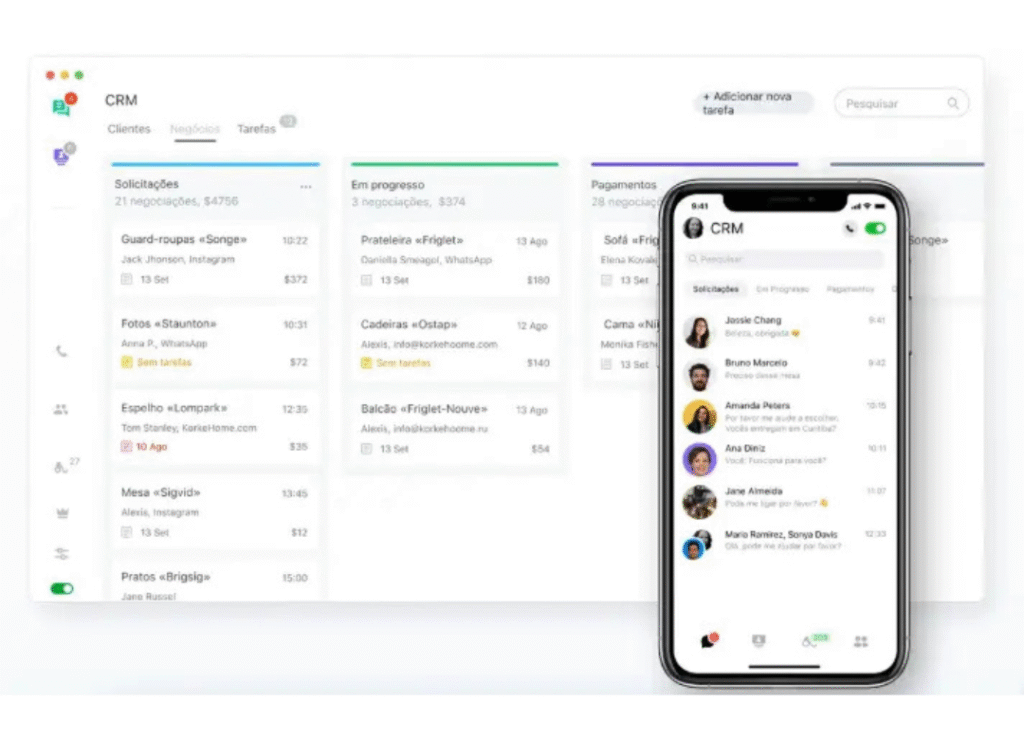Have you ever stopped to think about whether customers see your products as cheap or expensive? This perception is not only linked to the market price, but mainly to how each consumer sees the value of what they are buying.
The notion of value is subjective: an item that can solve an immediate problem is often seen as essential, even if it costs more. On the other hand, when the product is seen as dispensable, any price can seem high.
In the world of sales, it is common to focus only on offering the most competitive price. However, in addition to the financial cost, there is the weight of the customer’s perception of the investment made.
That is why companies from different sectors have been looking for ways to increase perceived value, often exploiting emotional, symbolic, and even psychological factors.
With that in mind, there are effective strategies for this, ranging from understanding audience behavior to investing in more qualified customer service. So, we are going to tell you everything about how to increase the value perceived by the customer. Check it out!
What is customer perceived value?
Perceived value is how customers evaluate the balance between price and benefits offered by a product or service.
This value should not be confused with price, since the same offer may seem expensive to one person and advantageous to another. It all depends on what each consumer considers relevant at the time of purchase.
This perception directly influences willingness to pay, affecting both the conversion rate and the profitability of a company. This is the basis of the value-based pricing model, in which the final price is defined by the impact and benefits that the customer sees, and not just by production costs.
Among the factors that create this perception are product quality and performance, options available on the market, brand reputation, and intangible aspects such as emotions associated with consumption and the experience offered before, during, and after the purchase.

What is the difference between price and perceived value?
Although they are related, price and perceived value are not the same thing. Price is the financial amount paid by the consumer. Perceived value, on the other hand, is the subjective assessment that consumers make of the return they obtain, whether in terms of quality, benefits, convenience, or personal satisfaction.
When customers understand that the gains outweigh the amount paid, the chances of purchase increase significantly. Therefore, working on perceived value is one of the most effective strategies for increasing sales and building customer loyalty.
A simple example: imagine buying a refrigerator with an extra compartment in the freezer. For those who live in a small space, this feature solves a practical need and makes the investment worthwhile, even at an above-average price.
For someone without this need, however, the same appliance may seem expensive and unattractive. This example shows how perceived value is relative, varying according to the needs, expectations, and context of each customer.
How to increase the value perceived by the customer?
Perceived value can be understood as the judgment that customers make when comparing the benefits they receive with the financial investment required. In other words, they evaluate the relationship between quality and cost and, based on that, decide whether the purchase was advantageous or not.
This understanding has a direct impact on purchasing behavior: when the experience is positive, consumers tend to return and even recommend the brand; on the other hand, a negative perception can lead them to seek alternatives in the market.
Therefore, a good evaluation strengthens the company’s positioning, facilitates the acceptance of new products, and increases public confidence. How can this be applied on a daily basis? Below are 14 practical strategies to increase the value perceived by the customer.
1. Get to know your audience deeply
To offer value, you first need to understand what your customer considers important. Creating a persona helps gather data such as demographic profile, needs, habits, and expectations. With this information, it becomes easier to identify the factors that influence the purchase decision.
2. Highlight benefits, not just features
When communicating your solution, show how it solves problems and generates advantages, rather than focusing solely on technical specifications. Features such as size, material, or capacity can be included in the product description, but the message should focus on the positive impact for the consumer.
3. Develop a solid value proposition
A useful resource is the Value Proposition Canvas, which connects the customer profile to the company’s solutions. This model helps identify:
- Customer tasks: what they need to accomplish.
- Pain points: difficulties or frustrations they face.
- Gains: expected benefits.
On the other hand, you list your products and services as follows:
- solve problems,
- alleviate pain,
- and create real gains.
This alignment makes it clear whether your offering truly meets what your audience is looking for.
4. Invest in the whole experience
According to a PWC survey, 55% of respondents said they would stop buying from a company after bad experiences. Therefore, it is not just the product that matters: every point of contact with the brand influences the perception of value. From advertising to after-sales, everything must be designed to delight.
Practices such as overdelivery, which consists of delivering more than expected, help to surprise and build loyalty.
5. Customize customer service
Treating each customer individually increases the feeling of care and exclusivity. A good CRM can help segment campaigns, offer assertive recommendations, and even adapt the language to the profile of each audience.
According to data from JivoChat, a CRM can increase your sales by up to 29%. That’s why we at JivoChat offer a CRM designed to help companies organize contacts, track negotiations, and centralize customer relationships in one place.

JivoChat CRM already integrates with the most commonly used communication channels, such as WhatsApp, Instagram, Facebook, Telegram, email, and telephone.
6. Strengthen your brand with branding
Branding goes far beyond creating a beautiful logo: it is about building a striking and consistent identity. Choose your colors carefully, define a consistent tone of voice, and create a brand persona that represents the essence of the company. This way, consumers will easily recognize and identify with the brand.
7. Build authority in the market
Being seen as an expert brings credibility and increases the value of your offer. To achieve this, work on actions such as:
- produce quality content,
- rank well in search engines,
- publicize awards or certifications,
- share success stories and customer testimonials.
8. Reward customers
Incentive programs, with discounts, gifts, or benefits for frequent purchases, are excellent for stimulating loyalty. In addition to building loyalty, these actions reinforce the feeling that customers receive more value when choosing your brand.
9. Create a structured loyalty program
A points system, benefit levels, or advantage clubs make customers perceive additional value in their purchases. This reduces turnover and increases your loyal customer base.
10. Produza conteúdo relevante
Educational or informational materials, such as articles, e-books, videos, and social media posts, help attract customers and reinforce brand authority. This type of content increases trust and makes the product more valuable.
11. Surprise in after-sales
Small gestures after the purchase make a difference: a thank-you note, an unexpected gift, usage tips, or exclusive coupons. These details show care and reinforce that the customer made the right choice.
12. Provide excellent customer service
Research shows that customers are willing to spend more with companies that provide good service. To stand out, offer multiple channels, humanize interactions, and facilitate access to information through a well-structured FAQ.
13. Showcase success stories
More than just a social proof resource, success stories help highlight the real value of a product or service, showing in practice the positive impact that a solution has had on a particular customer.
In addition to being a commercial strategy, this type of content reinforces consumer confidence when choosing a company, as it proves its ability to deliver quality service and generate value.
14. Ask for feedback regularly
Listening to customers is essential for continuous improvement. Satisfaction surveys reveal strengths and areas for improvement, ensuring an increasingly better experience and, consequently, greater perceived value.

Factors influencing perceived value
Customer perception of value is not defined by a single aspect, but rather by the sum of different elements. Among the most relevant, we can highlight: product or service quality, customer service, price, and brand strength.
1. Product or service quality
Quality delivery is one of the main factors that influence how consumers view a purchase. This concept goes beyond the physical item or service delivery: it also involves production, delivery, and after-sales processes.
When a company commits to high standards, it naturally increases customer trust and appreciation.
2. Customer service
The way consumers are treated in each interaction directly shapes their perception of value. Agility in solving problems, cordiality in contact, and attention to individual needs make all the difference.
Excellent support not only builds loyalty but also generates spontaneous recommendations and strengthens the company’s reputation.
3. Price
Price is a sensitive factor in the value equation, but it should not be viewed in isolation. Consumers often associate higher prices with superior quality, while lower prices may suggest lower credibility.
However, if the experience and service are consistent, even a higher price tends to be accepted and perceived as fair.
4. Brand and reputation
Brand image and credibility in the market weigh heavily on purchasing decisions. Businesses that cultivate a strong identity, maintain consistency in communication, and collect good reviews gain greater public trust.
This solidity even allows them to charge more without damaging the perception of value, as the brand conveys security and prestige.
The importance of perceived value in e-commerce
In e-commerce, perceived value acts as a competitive advantage. It helps raise the concept of cost-effectiveness in the eyes of the consumer, allowing your brand to be remembered not only for its price, but for the complete experience it offers.
When done well, this factor makes it easier to get pricing right, enables higher profit margins, and reduces the need to rely on constant discounts to attract buyers.
Among the main benefits of investing in perceived value in e-commerce are:
- Increased conversions: customers who feel that what they receive is worth more than the price paid tend to buy more easily;
- Loyalty: satisfied consumers return and become repeat customers;
- Spontaneous referrals: positive experiences generate recommendations, expanding the brand’s reach;
- Possibility of higher prices: a solid perceived value justifies higher charges and improves profit margins;
- Market differentiation: helps highlight benefits and qualities that competitors do not offer;
- Greater customer satisfaction: when the cost-benefit ratio is seen as fair, loyalty increases;
- Reduced CAC (customer acquisition cost): loyalty and recommendations reduce dependence on large investments in prospecting;
- Basis for more effective marketing strategies: understanding how customers perceive value helps create more assertive campaigns.
Have you learned how to increase the value perceived by the customer?
We hope this article has helped you understand everything about increasing customer perceived value. Now it’s time to put it into practice! Use JivoChat to centralize conversations, automate processes, and deliver a high-level experience.

